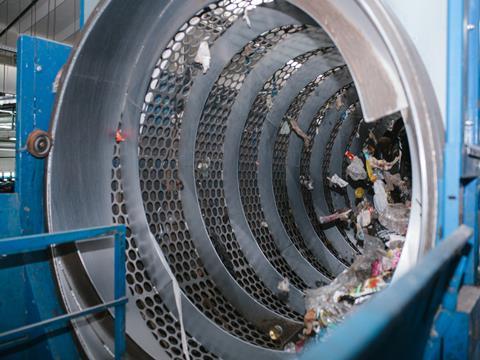
RecyClass, a cross-industry initiative working to advance plastic packaging recyclability and traceability in Europe, has unveiled its ‘Sorting Evaluation Protocol for Plastic Packaging’, which is geared towards companies that would like to analyse how packaging can be sorted after use.
The group defines a product as recyclable if it can be collected, recycled in a commercially available process, used in the manufacture of new products, and – as emphasised by RecyClass’s new protocol – sorted into an aggregated stream. This definition was first developed by the Association of Plastic Recyclers (APR) and Plastics Recyclers Europe (PRE) in 2018.
However, the group also notes that a product is not automatically designated as recyclable if it meets the above criteria. Recycled material is available in different quality grades, which depend on factors such as the input material, and this can influence how a package fares in each of these categories.
According to the group, recyclability should be assessed at every step of the recycling process in order to determine whether a company can claim that a product is recyclable. RecyClass has therefore developed the “comprehensive” Protocol to allow the specific design of each package to be assessed at all stages in its collection, transportation, and sorting.
The Sorting Protocol is intended to provide a testing methodology with detailed procedures and sampling methods. It aims to recognise design issues that may prevent the detectability of a product, such as a large label or a sleeve made from a different polymer than the main body of the product, which could lead to it ending up in a different stream.
The protocol can assess the sorting behaviour of plastic packaging at an industrial scale for seven recycling streams: PE flexibles, PP flexibles, PET bottles, PET trays, PP rigids, HDPE rigids, and PS rigids. It includes packaging such as pouches, bags, bottles, tubes, and cups, among others.
The group has developed specific Protocol Evaluation Lists for PE film, HDPE containers, PP containers, and PP films.
The group also worked with SUEZ.circpack® and NTCP to assess the feasibility and operational aspects of the protocol, using its sorting lines and Test Centre respectively. While at these sorting facilities, packaging undergoes testing using the following methods: sieve drum, wind sifter, magnet, eddy current, ballistic separation, and NIR detection.
Packaging will pass the RecyClass Sorting Protocol test if more than 50% of the packaging ends up in the stream corresponding to the resin used for the packaging body. Unless the sorting efficiency is higher than 80% – with residues either not sorted or sorted in the mix streams – a penalty will be applied at different efficiency percentages to connote how sortable the package is.
RecyClass says that any company interested in a third-party analysis of the sortability of its innovative packaging to identify sorting issues can contact the group to learn about the process. It emphasises that complying with the Protocol is not a replacement for an official assessment and cannot be used as a marketing tool by participating companies.
The group is also looking to collaborate with other sorting centres across Europe and urges interested organisations to apply to become an accredited sorting facility.
Martine Brandsma, director of NTCP, conludes: “The ‘Sorting Protocol for Plastic Packaging’ complements the Recyclability Evaluation Protocols.
“Sharing and implementing best practices and standards in the collection and sorting, as well as harmonising them across Europe, must follow now if we are to move the needle on design for recycling further.”











